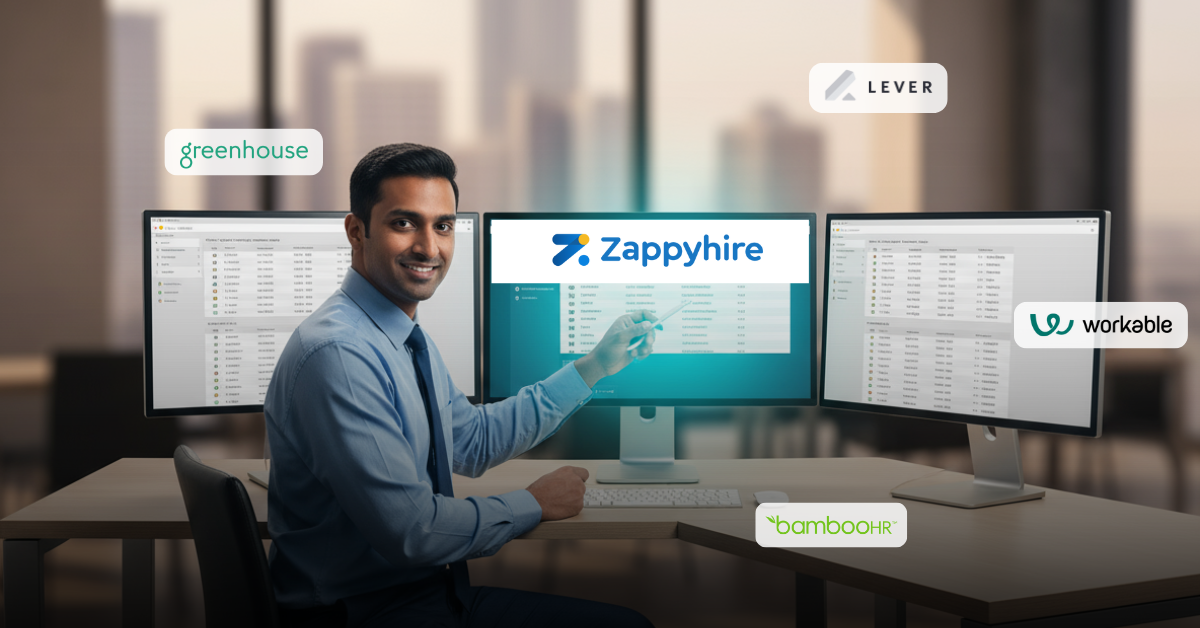
Recruiters are no strangers to managing competing demands. But, when faced with high-volume recruiting challenges – like filling hundreds or even thousands of roles in a short window – the stakes are even higher.
“What works for 50 hires a year will break completely at 1,000 hires.
– Deepu Xavier, co-founder of Zappyhire
What is high-volume recruitment?
High‑volume recruiting (also called mass hiring or bulk hiring) refers to the process of filling large numbers of roles quickly. It’s common in sectors like retail, IT, hospitality, call centres and logistics when seasonal peaks or rapid expansion drive urgent hiring needs.
Top high‑volume recruiting challenges from a data-driven perspective
High-volume recruiting is no easy feat. Recruiters face multiple hurdles – sourcing enough candidates, managing floods of applications, ensuring positive experiences, maintaining quality, and reducing ghosting…all within tight budgets and rising expectations.
Let’s take a closer look at the most common high-volume recruiting challenges and how to solve them.
1. Sourcing enough qualified candidates
Finding enough qualified applicants is the number‑one obstacle for high‑volume recruiters.
What the data says
Finding enough qualified applicants is the number‑one obstacle for high‑volume recruiters. In a survey, more than half of employers cited too many low‑quality applicants (60%) or not enough candidates (53%) as their top challenge.
This mismatch often stems from generic job ads and inadequate targeting. Meanwhile, the average time to fill a role is 44 days, yet the best candidates leave the market after only a few days.
Remote roles attract even more competition as a typical remote job posting can receive over 1000 applications.
What to do about it
Targeted outreach – Invest in programmatic advertising and specialised job boards so your postings reach the right audience.
Reports show that 83% of organisations consider job boards the most effective channel for high‑volume recruitment, followed by employee referrals (64%) and paid social media (57%).
Build a warm talent pool – Maintain a database of past applicants and silver‑medallist candidates.
During high‑volume campaigns, reaching out to people who already know your brand can drastically shorten time‑to‑hire.
Clarify job requirements – Use clear, concise descriptions and pre‑screening questions to filter out mismatched applicants. A streamlined, mobile‑friendly application flow reduces friction and improves candidate quality.
2. Managing and evaluating a flood of applications
Handling hundreds or thousands of applications manually can overwhelm even experienced recruiters.
What the data says
More than 65% of high‑volume hiring leaders automate as much of the process as possible. Yet many companies still sort résumés by hand or rely on spreadsheets, leading to missed opportunities and poor candidate experiences.
What to do about it
Adopt the right technology – Choose an ATS or recruitment automation platform that can handle high volumes, integrate skills assessments and provide real‑time analytics. Pair it with AI‑driven tools for résumé parsing and candidate matching to surface qualified talent quickly.
Automate repetitive tasks. Use software to automatically screen résumés, send status updates, schedule interviews and deliver personalised feedback. Automation improves consistency and ensures no candidate falls through the cracks.
Leverage video and asynchronous interviews. Video interviewing platforms like ZappyVue can save time for both recruiters and candidates, especially when roles are remote or distributed
3. Delivering a positive candidate experience at scale
Candidate experience has a direct impact on recruitment outcomes and your employer brand. Unfortunately, it’s an area where many high‑volume recruiters struggle.
What the data says
Poor communication is the biggest complaint – Two‑thirds of candidates (65%) say they didn’t receive consistent communication during the recruiting process.
Many candidates wait one to two months to hear next steps, and 35% never receive any acknowledgment of their application. Almost half (47%) of candidates say poor communication would make them withdraw from the process.
Lengthy and complicated applications deter talent – 49% of job seekers say most job applications are too long and complicated, and 33 % would abandon a clumsy or repetitive application.
What to do about it
Communicate early and often – Automate status updates, set expectations at each stage and personalise messages. Even a quick “thank you for applying” can improve perceptions.
Shorten your application – Ask only for essential information, enable candidates to apply with a résumé or LinkedIn profile and ensure the process is mobile‑friendly.
Provide feedback – With the help of recruitment automation tools, enable sharing feedback with candidates to communicate why they weren’t selected
4. Maintaining quality while moving fast
When you have only weeks to fill hundreds of roles, quality can suffer. Rapid hiring increases the risk of mismatches, higher turnover and lower productivity.
What the data says
Managing to fill quickly roles because of employee turnover and compensation/budget concerns rank among the top high‑volume hiring challenges.
What to do about it
Structured interviewing and assessments – Use standardised interview guides, behavioural questions and role‑specific tests to evaluate skills fairly.
Structured approaches reduce bias and using automated video interviews allow multiple interviewers to compare candidates objectively.
Skills‑based screening – Implement pre‑hire assessments to measure hard and soft skills before investing time in interviews. Many organisations use automated pre‑hire assessments to improve fit.
Data‑driven decision making – Track metrics like quality of hire, turnover rates and time‑to-productivity to identify where your process is working and where it needs improvement. Combining human judgment with analytics reduces reliance on gut instinct and helps you learn from each hiring cycle.
5. Ghosting and candidate reliability
Candidate ghosting is one of the overlooked high-volume recruiting challenges where candidates accept an offer but fail to show up, wasting time and money
What the data says
It’s a considerable or major problem in 36% of organisations (29% consider it considerable and 7% consider it a major issue). Reasons include better offers elsewhere, inaccurate job descriptions or negative perceptions of company culture
What to do about it
Clarify roles and expectations early – Communicate duties, schedules and compensation clearly in job ads and during interviews.
Features like smart JD recommendations in AI recruitment platforms like Zappyhire, help recruiters create optimized JDs keeping all aspects of the role in mind.
Check candidate intent – Use targeted questions and behavioural interviews to gauge commitment. Provide opportunities for candidates to ask questions about the role and culture.
Strengthen your employer brand – A strong brand and positive candidate experience can improve loyalty and reduce ghosting
6. Budget, compensation and candidate expectations
Cost is another stumbling block. With labour shortages, companies often raise wages to attract talent.
What the data says
Research shows that 72% of organisations increased wages, 52% improved benefits and 47% added flexibility to stay competitive. While necessary, salary hikes can lead to pay compression and strain budgets.
What to do about it
Conduct market research – Benchmark compensation regularly and adjust pay scales based on skills and experience rather than across‑the‑board increases.
Enhance benefits and perks – Offer flexible schedules, wellness programmes, training and career advancement opportunities. These non‑salary incentives can be cost‑effective and highly attractive to candidates.
Communicate salary ranges up front – 74% of candidates are looking for salary information when researching an employer
Why is AI and automation so critical in solving high‑volume hiring challenges?
In high‑volume hiring, the sheer number of applicants can easily overwhelm traditional recruitment processes.
Manually screening thousands of resumes, scheduling interviews, and keeping candidates updated is not only time-consuming but also prone to errors and delays.
Recruitment automation tools like AI-powered Applicant Tracking Systems (ATS) and automated video interview platforms handle repetitive tasks at scale, such as bulk resume screening, candidate shortlisting, and even scheduling.
In short, automation transforms high-volume recruitment from a chaotic, resource-heavy process into a streamlined and efficient operation.
Here’s how automation powers each stage of high‑volume recruitment:
| Hiring Stage | Without Automation | With Automation |
|---|---|---|
| 1. Sourcing | Recruiters manually post jobs and track applicants across multiple channels. | Job postings are distributed to multiple platforms automatically, reaching a wider pool instantly. |
| 2. Screening | Hours (or days) spent going through resumes, risking human error and missed talent. | AI quickly scans resumes, scores candidates, and shortlists the best fits in minutes. |
| 3. Interview Scheduling | Endless back‑and‑forth emails to find mutually available slots. | Automated scheduling tools send invites, sync calendars, and reduce no‑shows effortlessly. |
| 4. Assessments & Interviews | Manual coordination and subjective evaluations slow the process. | Automated video interviews and assessments standardize evaluation while saving recruiter time. |
| 5. Candidate Engagement | Candidates often feel neglected due to delayed updates. | Automated updates and reminders keep candidates engaged and informed at every step. |
| 6. Offer & Onboarding | Paperwork bottlenecks delay final hires. | Digital offer letters, e‑signatures, and automated onboarding speed up the final step. |
How do high-volume recruitment challenges differ from regular recruitment?
High‑volume recruitment isn’t just “more of the same” compared to regular hiring – it’s an entirely different game.
Deepu Xavier put it this way,
“[In enterprise recruitment]…the applicants are higher in number, the stakeholders are higher in number, the queries from the candidates are higher in number. When all these things go on a higher number… approvals will be delayed, interview feedback will be delayed, no-shows by interviewers will increase.”
And we couldn’t agree more.
In regular recruitment, you’re usually filling a few roles with plenty of time to source, screen, and nurture candidates. High‑volume hiring, on the other hand, often means filling hundreds (or even thousands) of positions under strict deadlines.
High volume recruitment vs regular recruitment
| Aspect | Regular Recruitment | High‑Volume Recruitment |
|---|---|---|
| Number of Roles | Few to a dozen positions at a time | Hundreds to thousands of roles simultaneously |
| Time Pressure | Moderate; hiring cycles can be longer | High; roles need to be filled quickly to meet business demands |
| Candidate Volume | Manageable, usually easy to track manually | Overwhelming, requiring automated systems to handle screening and tracking |
| Candidate Experience | Easier to personalize | Needs tech to maintain a positive and consistent experience at scale |
| Process Complexity | Can manage simple workflows with manual steps | Complex workflows that demand automation and efficient coordination |
| Tools Required | Basic ATS or spreadsheets | Advanced ATS, automation, and AI features |
Technology and steps to overcome high‑volume recruiting challenges
Outsourcing and partnerships
Most enterprises outsource at least part of their high‑volume recruitment to third‑party providers.
Partners often include staffing agencies, job boards and aggregators, temporary employment services and recruitment process outsourcing providers.
Outsourcing can alleviate internal bottlenecks, provide specialised expertise and scale hiring quickly.
AI, automation and barrier removal
The most effective high‑volume recruitment practices include automating as much of the process as possible.
They lean on agentic AI tools and enterprise recruitment software that can independently handle repetitive tasks like screening, shortlisting, and scheduling, as it removes friction for both candidates and hiring teams
Leveraging diverse channels
In addition to job boards, employers find success using employee referrals, niche sites and programmatic advertising. Social media channels, online communities and targeted ads broaden reach.
Many organisations also tap into existing talent pools, alumni networks and internal mobility programmes to keep pipelines full.
Investing in candidate experience
Nearly half of employers (48%) now rate improving candidate experience as a top talent‑acquisition priority. Yet only half have been able make improvements to their candidate experience, and only 11% track candidate satisfaction.
AI-powered recruitment tools close this gap – automating updates, ensuring consistent engagement, and creating a positive experience for every candidate.
Measuring candidate sentiment, iterating based on feedback and tying candidate‑experience metrics to recruiter performance ensures this priority doesn’t get neglected.
All you need is a clear strategy and the right tools
Automating repetitive work, focusing on candidate experience, and leveraging targeted sourcing channels are the keys to filling large numbers of roles without sacrificing quality.
The market is competitive – but with this guide and the right tools, you can build a high‑volume hiring engine that delights candidates and delivers results.





